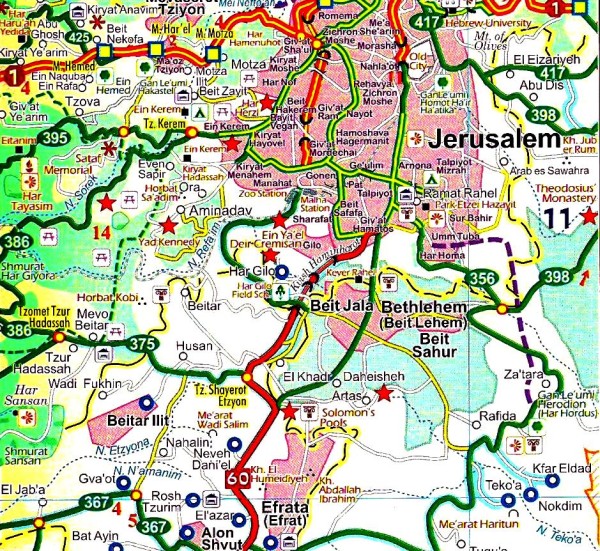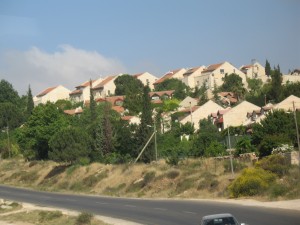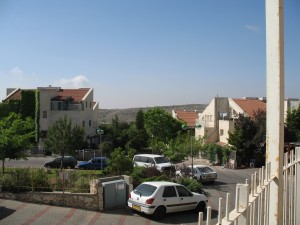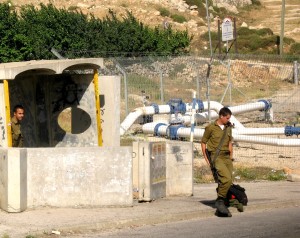Page 7 - Efrat
Here is a map of some of the area we have been talking about. You
can see Jerusalem, going south is Bethlehem, on its south edge is the
"Daheisheh" refugee camp.

Let's go a bit further south, to the settlement of Efrat.
Efrat is within the bounds of the 1948
to 1967 "West
Bank", and is regarded by its Jewish residents as a suburb of
Jerusalem. The "security boundary" includes it on the Israeli
side. From the point of view of an American developer or city
planner, working without regard to politics, it is a very logical place
to have a suburban development, and it is a very attractive modern
suburban city, with shops, synagogues, and attractive plantings.
It is on the top of a string of small hills, with pretty views of the
surrounding agricultural land. There are convenient road
connections for those commuting to jobs in Jerusalem or even Tel
Aviv. The population of immigrants from the US is large
enough to make it attractive to Americans, and I am told and believe
that most residents have come because they find it an attractive and
convenient suburb and a good place to raise children.


The founders of Efrat, we were
told by the local spokesman, arrived at a time when it was still
expected that there could be peaceful coexistence, cooperation,
and friendship between the Israelis and Palestinians. I recall
that feeling well; it was very prevalent when I was first in Jerusalem,
in 1971, and the economy was booming. The first land was purchased
peacefully and Palestinians from the surrounding villages often
worked in Efrat.
Later, of course, the Intifadas
came. The expansion of Efrat became controversial (now, even the
central Israeli government discourages Efrat from expanding onto a
neighboring hillside) and there was a real fear of attacks from radical
Palestinians.
The Palestinian view of these
settlements is, of course, different. Many object to any
settlement of Jews in areas Israel conquered in 1967.
Israelis point out in reply that the border of 1948 to 1967 were never
recognized by any of the surrounding countries; why is Israel supposed
to be bound by them now?
Land titles are often obscure: between 1918
and 1948 the British never developed a system for recording the old
Turkish land titles, and deeds may well be disputed. And as in
the US, decisions by governments to annex land or change its use are
not always welcomed by the landowners. For example, Israel prefers to
expand Jerusalem suburbs onto land not being actively farmed. They can
show you photographs showing that "this field was abandoned, not being
farmed, when we rezoned it." The locals retort: "Hey, grape vines
can get a disease. When they do, you cut them down and leave the field
fallow for a year or two before replanting. We can show you
photographs showing the grape vines here two years earlier."

Everyone agrees that Efrat sits
on a major aquifer, and controls a major source of water for the area.
Was this coincidence? Was it because a builder found it easier to build
a new town where there was readily available water? Was it because a
nationalist Israeli saw a chance to impede Palestinian access to
water? I don't find it useful to answer such questions. My
wife Eunice has been a mediator in the Memphis court system: she
can tell us that in many disputes, trying to agree on past facts is
neither easy nor even necessary. It is necessary for both sides
to be heard; for both sides to feel the other has heard their
story. And then it is often possible to figure out and even
agree on what should happen in the future.
What should happen in the future,
in Efrat? That's a hard one. It, and other settlements
like it, tend to "break up" Palestine. It is very hard to imagine
a system of roads that allow Jewish areas and Palestinian areas both to
be connected, even using bridges and tunnels. In a truly peaceful
solution, it might be possible to have scattered pockets of Jews living
among the Palestinians, fair sharing of water, cooperating police
forces that served two different populations, with appropriate
solutions for people who have lost homes and fields to war, security
barriers, and urban development. But that sort of peace may be a
great many years in the future.
One possible way of hoping for a
nearer-term solution, but possibly equally far-fetched, is the
following thought: Israel has shown it has the money and the
technological ability to build new communities, and large quantities of
housing, remarkably quickly. The recent absorption of about a million
arrivals
from the former Soviet Union was remarkable. It would be possible to
provide new housing for the Palestinians in refugee camps. It would be
possible to have a working economy in the West Bank and Gaza, so that
people could have jobs and schools to go to instead of bomb factories
and protest meetings. Some Palestinians will not get their
original homes and land back, but homes and water and agricultural
land can be found for those that want them. And if some Jewish
settlements have to be relocated, new ones can be built and those
people also may have to live in places that are not their first
choice.
Peace will require
sacrifices from a lot of people, including American Jews like me -
because it will cost a lot of money, and a lot of that money will have
to come from people like me. But I'd rather spend it on houses and
desalinization and irrigation and building schools than on guns and
bombs and wars, and compared to the cost of the guns and bombs and
wars, it is really not prohibitively expensive.
Ordman Net Home
Israel/Palestine Info Home
CONTENTS:
Page 1: Introduction
Page 2: Kfar Shalem
Page 3: Duheisha Refugee Camp
Page 4: Universities
Page 5: The Wall / Security Barrier
Page 6: Bethlehem
Page 7: Efrat
Next> Page 8: Hebron
(More to come)



